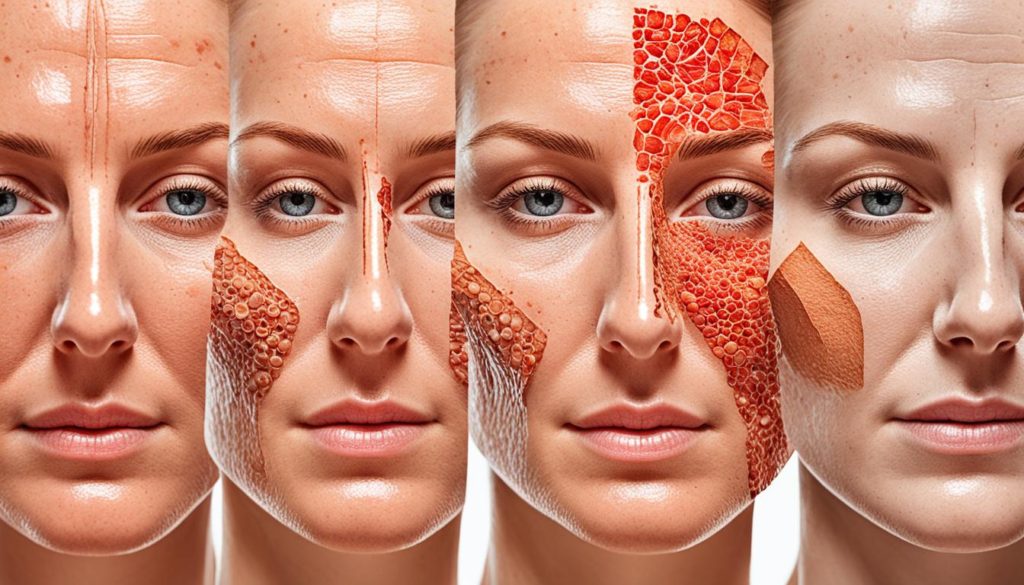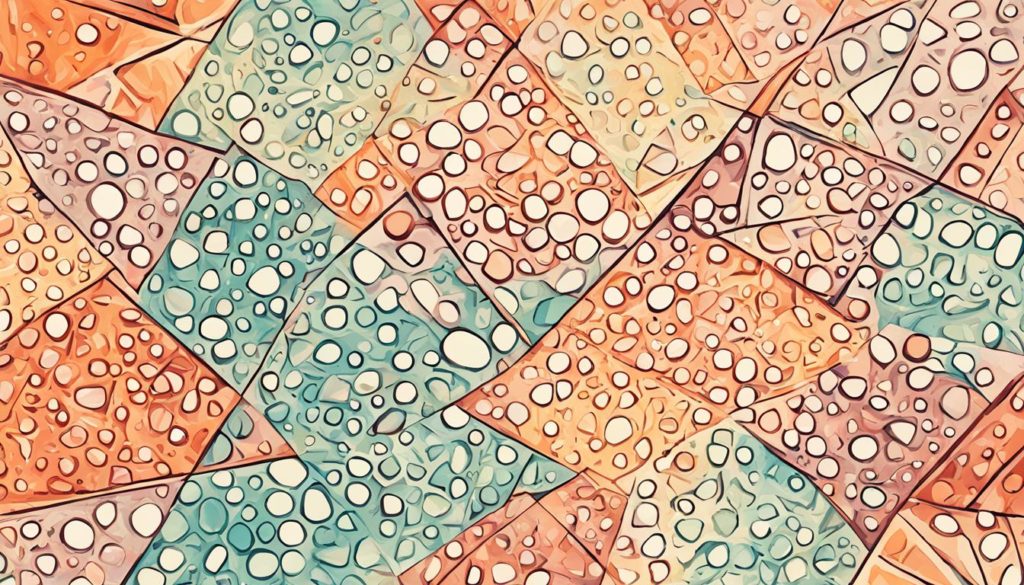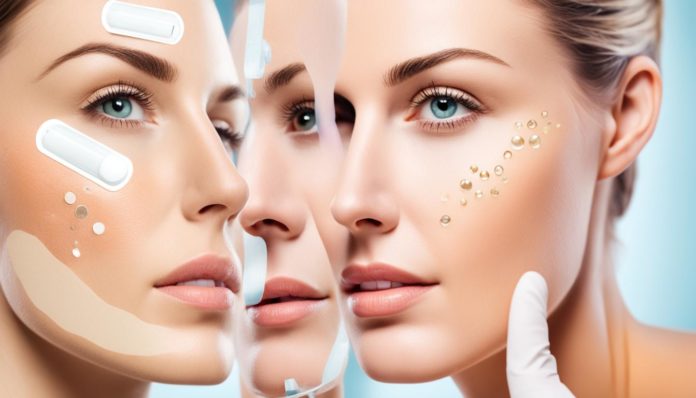Did you know 85% of people aged 12-24 experience acne at some point? Many of them face lasting acne scars even after breakouts are gone. Thankfully, recent scientific breakthroughs offer many treatment options. These options range from creams to procedures, opening new doors to clearer skin.
Dealing with acne scars can be tough. It’s crucial to know about different skincare solutions for acne scars. This article talks about reliable treatments that help reduce acne scars. These treatments bring hope and uplift spirits.
Key Takeaways
- A significant percentage of young people experience acne, leading to potential scarring.
- Advancements in dermatology have introduced various effective acne scars treatment options.
- Both topical and procedural treatments offer potential solutions for acne scar reduction.
- Understanding the types of acne scars can help tailor the most suitable treatment approach.
- Exploring various skincare solutions for acne scars is essential for effective results.
Understanding Acne Scars
Acne scars appear during the acne wound healing process. This process has several stages like inflammation, tissue formation, and remodeling. If the skin gets hurt from acne, the body makes collagen to fix it. Sometimes, though, this repair process doesn’t work right, leading to types of acne scarring.
Many things affect acne scar formation. The depth and how long acne stays matter. Deeper and longer-lasting acne may scar more. It’s vital to know how the acne wound healing process works. This knowledge helps us understand scar development and treatment.

The skin’s elasticity, immune reactions, and genes also impact scar formation. There are different types of acne scarring. Each type needs its treatment plan. Knowing why scars happen helps pick the right treatment.
In summary, understanding acne scar formation and the causes behind scars is crucial. It gives us a good start to tackle them. By learning about each scar type and treatment options, we can better address and treat acne scars.
Types of Acne Scars
Knowing about acne scars helps in choosing the right treatment. We’ll explore the main types of acne scars, how they look, and why they appear.
Atrophic Scars
Atrophic scars are shallow spots left on the skin. They occur when there’s not enough tissue beneath the skin. These count:
- Boxcar scars: Wide with steep edges.
- Ice pick scars: Deep, thin pits looking like puncture marks.
- Rolling scars: Making the skin look wavy and uneven.

Atrophic scars occur after collagen breaks down. This happens after having severe acne. They are common on the face, back, and shoulders.
Hypertrophic Scars
Hypertrophic scars are raised and thick from too much collagen. They often appear on the back, shoulders, and jawline. Keloid scars are an extreme type of hypertrophic scars. They grow bigger than the original injury, causing pain and cosmetic issues.
Post-Inflammatory Hyperpigmentation
This condition isn’t a real scar but involves skin color changes after acne. These spots can last for a long time. They’re frequent in darker skin tones, mostly on the face and back.
Topical Treatments for Acne Scars
Topical treatments are easy to get and help make acne scars less visible. They work right on the skin, helping to ease scars.
Over-the-Counter Creams
You can easily find creams to deal with acne scars at stores. Lotions with salicylic acid and niacinamide are very good. Salicylic acid cleans the skin and opens pores. Meanwhile, niacinamide cuts down swelling and makes skin smoother.
Prescription Medications
For tougher scars, doctors might suggest prescription creams. Retinoids are popular because they make skin renew faster and look smoother. Hydroquinone can make dark scars lighter and less easy to see. Sometimes, corticosteroids are given to lessen swelling and make bumpy scars flatter.
Here is a list of main ingredients and what they do:
| Ingredient | Benefits | Possible Side Effects |
|---|---|---|
| Salicylic Acid | Exfoliates skin, unclogs pores | Dryness, irritation |
| Niacinamide | Reduces inflammation, improves texture | None, generally well tolerated |
| Retinoids | Accelerates cell turnover | Redness, peeling |
| Hydroquinone | Lightens hyperpigmentation | Possible skin irritation |
| Corticosteroids | Reduces inflammation, flattens scars | Thinning of the skin, discoloration |
Best Acne Scar Products Available
Changing your skincare to include effective products is key for less acne scars. You need ingredients that help the skin heal and make more collagen. We will talk about great retinol creams, vitamin C serums, and exfoliators like glycolic and lactic acid.
Retinol Creams
Retinol is a type of vitamin A that speeds up skin renewal and makes more collagen, reducing acne scars. Dermatologists often recommend Differin Gel for its power against acne and scars. With regular use, your skin can become smoother and more uniform.
Vitamin C Serums
Vitamin C serums, like the ones from SkinCeuticals, are great for skin repair. They help make more collagen and brighten your skin. By fighting off free radicals, vitamin C lessens acne scar color, giving a brighter skin look.
Exfoliating Agents
Adding exfoliators like glycolic and lactic acid to your routine can vastly improve skin and lessen scars. Glycolic acid goes deep to help make collagen, while lactic acid exfoliates gently, good for sensitive skin. Try products like The Ordinary Glycolic Acid 7% Toning Solution and L’Oréal Paris Revitalift Bright Reveal for better results, giving clear, refreshed skin.
Using these strong ingredients regularly is the best way to rejuvenate your skin and reduce acne scars.
Laser Treatment for Acne Scars
Laser treatment for acne scars is very modern. There are many lasers used, like ablative and non-ablative ones. They are great at making acne scars less visible. They improve skin texture and break down scar tissue. This makes laser treatments a top choice for clearer skin.
Fractional Laser Treatment
Fractional laser treatment is a top pick for acne scars. It targets small skin areas without harming the rest. Laser resurfacing encourages new skin growth. Fractional lasers work well for many skin types and scar levels.
Pulsed Dye Lasers
Pulsed dye lasers focus on reducing redness and discoloration from acne scars. They work by targeting blood vessels in the scar. This enhances the skin’s texture and helps in healing. Pulsed dye lasers are safe for treating post-inflammatory erythema.
Talking to a dermatologist is the best way to learn about these treatments. They can give you details on what to expect and any risks. Consulting a professional is highly recommended.
Dermatologist for Acne Scars
Seeking a board-certified dermatologist is key when battling acne scars. They conduct a professional skin assessment to identify effective treatments for your skin. Dermatologists offer expert scar treatment advice, thanks to their specialized training and experience.
At a consultation, you’ll get a detailed professional skin assessment. It explores the causes of your scars and finds the best treatment. This personalized plan might include creams, lasers, or other procedures.
Benefits of Consulting a Dermatologist:
- Tailored treatments based on skin type and scar severity
- Access to medical-grade products and technologies
- Prevention of future scarring while treating existing scars
Board-certified dermatologists offer unmatched expert scar treatment advice. They help reduce scars and prevent new ones, giving you clearer skin.
Visiting a board-certified dermatologist provides a specialized and personalized strategy. It combines scientific expertise with the newest dermatological advancements.
Microdermabrasion and Chemical Peels
Discover the benefits of microdermabrasion and chemical peels for treating surface acne scars. Learn how each method helps in renewing the skin. This will help you choose the right treatment for a smoother, refreshed look.
Microdermabrasion
Microdermabrasion is a gentle process that refines the skin by removing the top layer. It uses fine crystals or a diamond-tipped wand. This method targets mild acne scars and makes the skin smoother.
Regular treatments, spaced a few weeks apart, are needed for the best results. This ensures your skin remains healthy and vibrant.
| Microdermabrasion | Chemical Peeling | |
|---|---|---|
| Treatment Type | Mechanical Exfoliation | Chemical Exfoliation |
| Key Ingredients | Fine Crystals or Diamond Tip | AHA and BHA Peels |
| Target Scars | Superficial Acne Scars | Superficial to Moderate Acne Scars |
| Aftercare | Moisturizer, Sunscreen | Hydration, Sunscreen |
| Frequency | Every 2-4 weeks | Every 6-8 weeks |
Chemical Peeling
Chemical peeling uses a mix of AHA and BHA peels to remove damaged skin layers. It boosts skin renewal and lessens acne scars. The strength of the peel affects the recovery time.
Lighter peels heal fast, while deeper peels need more time but give dramatic results.
Microneedling as a Treatment for Acne Scars
Microneedling is also known as collagen induction therapy. It’s a simple way to make acne scars look better. By using a tool called a dermaroller, with tiny needles, it works by poking the skin gently.
This method causes small injuries on purpose. It makes the body make more collagen and elastin. These changes help improve the skin’s texture, making scars less visible. Over time, patients see their skin get firmer and smoother.
Microneedling is safe but needs to be done right. It’s important to have a professional do it. After treatment, some might see redness or feel a bit of swelling or discomfort. Yet, these effects are usually mild and go away quickly.
In the end, microneedling can really help with skin issues. It makes scars less visible and improves how the skin feels and looks. But, it’s wise to talk to a skin doctor first. This way, you ensure great results and keep risks low.
Injectable Fillers for Acne Scar Removal
For those looking to see quick scar improvement, injectable fillers are a great choice. They address atrophic acne scars fast, offering a temporary but effective fix. They use things like hyaluronic acid and poly-L-lactic acid to smooth and even out skin texture.
Types of Fillers
There are mainly two kinds of fillers for acne scars: hyaluronic acid fillers and poly-L-lactic acid fillers. Fillers like Juvéderm and Restylane draw in moisture, giving an instant plump look. Poly-L-lactic acid fillers, like Sculptra, help make more collagen, which improves skin over time.
Procedure and Recovery
Getting injectable fillers is usually easy and doesn’t require much downtime. A dermatologist injects the filler into the scars after talking with you. The process is about 30 minutes, and you can go back to normal activities right away. You might see some swelling and redness, but it fades quickly.
Effectiveness and Duration
Injectable fillers work fast, making scars less visible right away. Hyaluronic acid fillers typically last 6 to 12 months. Poly-L-lactic acid fillers gradually make skin better, with results lasting over two years. Although not permanent, these fillers greatly boost confidence for those wanting quick results.
FAQ
What are the most effective acne scars treatment options?
You can treat acne scars in many ways. You have topical treatments, like creams you can buy or get prescribed. Laser treatments, microdermabrasion, chemical peels, microneedling, and injectable fillers are also options. The choice depends on your scar type and how severe they are.
How do acne scars form?
Acne scars appear during the healing of acne wounds. Deep acne damages the skin underneath. Trying to fix this damage, the body might make too much or too little collagen. This leads to different kinds of scars.
What are the different types of acne scars?
Acne leaves behind various scars like atrophic (boxcar, ice pick, rolling), hypertrophic, and post-inflammatory hyperpigmentation. Each has unique features and may need a special treatment approach.
What topical treatments are best for acne scars?
The best topical treatments for acne scars vary. Some over-the-counter options include creams with salicylic acid, niacinamide, and retinoids. Prescription options like hydroquinone and corticosteroids also exist. These can lighten scars, boost collagen, and smooth your skin.
Which acne scar products are most effective?
The most effective acne scar products include retinol creams, vitamin C serums, and exfoliants like glycolic and lactic acid. They rejuvenate the skin and boost collagen, which can make scars less visible.
How does laser treatment help with acne scars?
Laser treatments like fractional laser and pulsed dye lasers smooth the skin, cut down on scar tissue, and encourage collagen. This improves skin texture and can make acne scars less noticeable.
Why should I consult a dermatologist for acne scars?
A board-certified dermatologist can offer a custom treatment plan and expert advice. They can give treatments suited to your scar type, improving results and preventing new scars.
What is the difference between microdermabrasion and chemical peels for treating acne scars?
Microdermabrasion uses fine crystals to exfoliate the skin and encourage new growth. Chemical peels use AHA and BHA acids to take off damaged skin and help new skin come in. Both can smooth out minor acne scars and better the skin’s texture.
How does microneedling improve acne scars?
Microneedling or collagen induction therapy, uses tiny needles to slightly injure the skin. This promotes healing and more collagen, improving skin texture and making acne scars less visible.
What are injectable fillers, and how do they help with acne scars?
Injectable fillers like hyaluronic acid fill in sunken scars, making skin look smoother right away. They are injected under the skin to lift the scars. The results can last for months.


